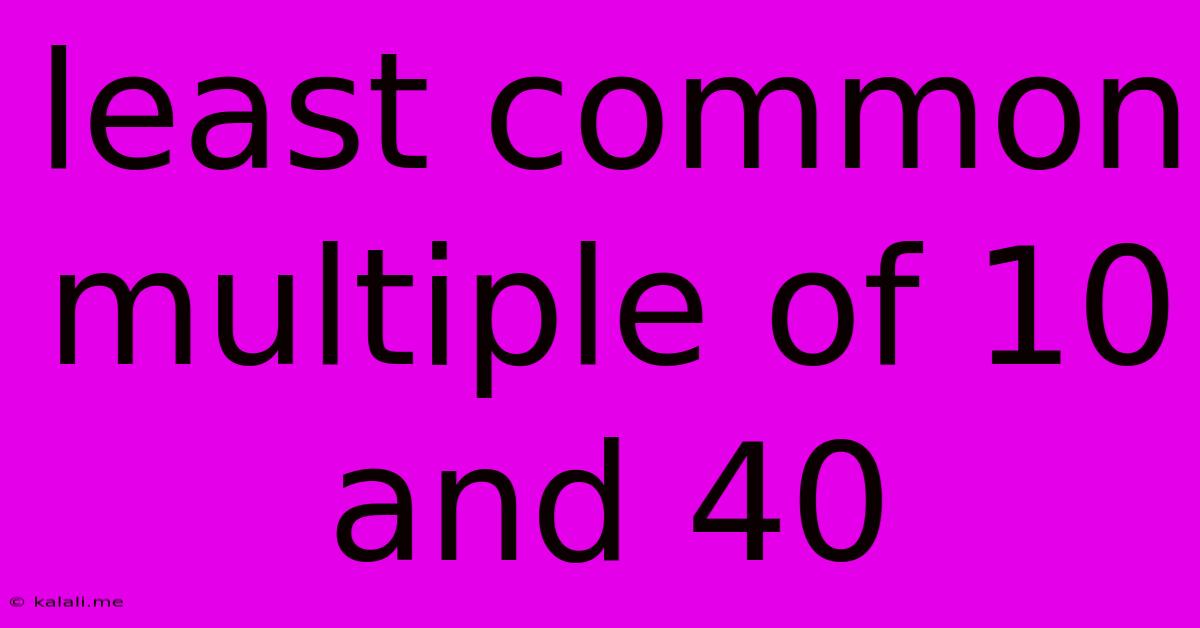Least Common Multiple Of 10 And 40
Kalali
Jun 14, 2025 · 2 min read

Table of Contents
Finding the Least Common Multiple (LCM) of 10 and 40
This article will guide you through understanding and calculating the least common multiple (LCM) of 10 and 40. We'll explore different methods, making this concept accessible for everyone from beginners to those wanting a refresher. Understanding LCM is crucial in various mathematical applications, including simplifying fractions and solving problems involving cycles or periodic events.
What is the Least Common Multiple (LCM)?
The least common multiple (LCM) of two or more integers is the smallest positive integer that is divisible by all the integers. In simpler terms, it's the smallest number that both (or all) numbers can divide into evenly. This is different from the greatest common divisor (GCD), which is the largest number that divides both numbers without leaving a remainder.
Methods for Finding the LCM of 10 and 40
There are several ways to find the LCM of 10 and 40. Let's explore two common methods:
1. Listing Multiples Method
This is a straightforward approach, especially for smaller numbers. We list the multiples of each number until we find the smallest multiple common to both.
- Multiples of 10: 10, 20, 30, 40, 50, 60...
- Multiples of 40: 40, 80, 120...
The smallest multiple that appears in both lists is 40. Therefore, the LCM of 10 and 40 is 40.
2. Prime Factorization Method
This method is more efficient for larger numbers. It involves breaking down each number into its prime factors.
- Prime factorization of 10: 2 x 5
- Prime factorization of 40: 2 x 2 x 2 x 5 (or 2³ x 5)
To find the LCM using prime factorization:
- Identify all prime factors: The prime factors involved are 2 and 5.
- Take the highest power of each prime factor: The highest power of 2 is 2³ = 8, and the highest power of 5 is 5¹ = 5.
- Multiply the highest powers: 8 x 5 = 40
Therefore, the LCM of 10 and 40, using prime factorization, is 40.
Understanding the Result
The LCM of 10 and 40 is 40. This means that 40 is the smallest positive integer that is divisible by both 10 and 40 without leaving a remainder. This is useful in various real-world scenarios, for instance, determining when two cyclical events will coincide.
Conclusion
Finding the least common multiple is a fundamental concept in mathematics. Both the listing multiples and prime factorization methods are effective ways to calculate the LCM, with the prime factorization method being particularly useful for larger numbers. Understanding the LCM helps in various mathematical operations and problem-solving. Now you have the tools to calculate the LCM of any pair of integers confidently.
Latest Posts
Latest Posts
-
What Is The Least Common Multiple Of 10 And 14
Jun 15, 2025
-
How Much Is Four Hundred Thousand
Jun 15, 2025
-
Who Was The First To Stab Caesar
Jun 15, 2025
-
Words That Describe A Good Mother
Jun 15, 2025
-
Which Statement Is True About Fossils
Jun 15, 2025
Related Post
Thank you for visiting our website which covers about Least Common Multiple Of 10 And 40 . We hope the information provided has been useful to you. Feel free to contact us if you have any questions or need further assistance. See you next time and don't miss to bookmark.